The increased visibility of “things Jewish” in contemporary Spain has re-energized, and in certain cases awakened for the first time, a wide array of desires to explore modes of reconnection to Spain’s Jewish past and its memory. In this context, Daniel Quintero’s work stands out as an effort to reconnect with the Iberian Jewish past that also reflects critically on the questions engendered by this process.
Born in Malaga in 1949, Quintero is a leading figurative painter who for over fifty years has been exploring what he describes as an “abstract naturalist” visual style in which figures, landscapes and portraits emerge from the canvas out of a keen attention to the abstract components of light, reflections and shadows emanating from the painted subject. His artistic practice has been intimately connected to the representation of the human figure since 1965, when he became a student in Amadeo Roca Gisbert’s Art academy in Madrid. Quintero went on to complete his studies at Spain’s preeminent art school, the Escuela Superior de Bellas Artes de San Fernando in Madrid. Yet, Roca Gisbert’s lessons have proved to be enduring guides throughout Quintero’s career. Like his mentor, Quintero emphasizes the importance of pencil and charcoal drawing as the foundation of his work; he understands his artistic practice as a continuation and revision of the tradition of the great Spanish classical painters, and his innovations incorporate the well-established genre conventions of portrait, still-life, and landscape paintings.
Quintero was only twenty years old when his work as a portrait painter captured the attention of gallerist Juana Mordó, who at the time was the most important dealer of Spanish modern art. In 1972, Quintero’s work entered the international art scene through a collective exhibition organized in London to showcase the work of Antonio López García (1936-) and a group of young new-realist Spanish painters. Quintero’s work for that exhibition, entitled En el Metro (In the Subway, oil on canvas, 1972), depicted a hyperrealist portrait of a man and a woman as they stand behind the timeworn doors of the Madrid subway. His inclusion in this seminal exhibition seems to have generated the perception of a close connection between Quintero’s work and that of the Madrid new-realist painters. Quintero himself, however, has expressed repeatedly that his work has no link to Antonio López García’s, neither as a disciple, nor as a follower of his aesthetics. Perhaps the most visible evidence of this difference is that, unlike the work of López García and his disciples, which gravitates towards landscape painting, Quintero’s artistic practice is centered on the portrait, which informs his approximation to other genres. Over more than 50 years, he has painted official portraits of leading figures in the realms of culture, science and politics, including members of the Spanish Royal family, film director Pedro Almodóvar, writer Manuel Vicent, Manuela Carmena—painted in 1993 during her time as a judge, before she became Madrid’s mayor (2015-2019)—as well as former presidents Adolfo Suárez (1976-1981) and Leopoldo Calvo-Sotelo (1991-1992).
In contrast with these portraits of contemporary public figures, his “Sephardi portraits” stand as a project deeply embedded in a sustained and intentional exploration of a single topic, the larger process of Spain’s “reconnection” with Jewish history, culture and practices. The project encompasses complementary groups of paintings on which Quintero has worked since the early 1990s. The first group portrays contemporary religious and political leaders of Sephardi communities in France and Spain. The second group consists of imaginary portraits of various medieval and early modern Iberian-Jewish historical figures. Besides these two, a third group is composed of still lifes of food arrangements and material symbols of traditional Jewish celebrations. While thematically these paintings belong to three distinct temporalities (the present implied in the contemporary portraits, the past evoked by the historic portraits, and a trans-historical dimension embodied in symbols and rituals captured in the still lifes) they all show a remarkable convergence in terms of themes and style.
As Stuart Hall reminds us, identity, like memory, is not something that can be “discovered” or “recovered,” but something that is continually in production, something that is practiced in particular social and cultural contexts. The stories communities tell about their pasts are of utmost importance in this process, especially in terms of how these stories affect people belonging to particular groups and communities. As Hall puts it, “far from being grounded in a mere ‘recovery’ of the past, which is waiting to be found... identities are the names we give to the different ways we are positioned by, and position ourselves within, the narratives of the past.” 1 Quintero’s paintings construct a particularly rich story of a shared Iberian-Jewish past. They are also emblematic of how this past has been re-explored and claimed in contemporary Spain.
In order to read these paintings as interventions in the ongoing process of re-engagement with the memory of Jewish Spain, and the new identity positionings this process has set in motion, we experiment with what Shelley Ruth Butler and Erica Lehrer call “curatorial dreaming.” Curatorial dreaming is “an innovative method of engaged cultural analysis and critique,” a way for critics and scholars to “curate our arguments” through imagining exhibitions of our own.2 As Butler and Lehrer argue, “[e]xhibits naturalize particular ways of looking at the world. They can also clear paths for new ways of seeing.”3
Our “dream exhibition” places Quintero’s paintings in dialogue with the great Spanish masters. We view his portraits as formally embracing and intervening in many of the conventions explored by painters such as Diego Velázquez, Francisco de Goya and José de Ribera. They all belong to a peculiarly Spanish tradition of developing the portrait as a tool of social commentary. Similarly, Quintero’s still-life paintings contain frequent allusions to the classical bodegón paintings of the Spanish baroque by artists such as Pedro de Acosta, Blas de Ledesma, Juan Sánchez Cotán, Francisco de Zurbarán and Pedro de Medina Balbuena. Like them, Quintero’s still lifes endow everyday foods and wares with a sense of symbolic immanence. While being intensely material in their realism, their composition and status as representation endows them with a mystical dimension. Yet, this group of paintings also push these classical Spanish visual traditions into a conceptual territory that they had all but overlooked: explicitly, Quintero embraces in them the Iberian Jewish past and present.
Like Velázquez and Goya, Quintero’s equal artistic treatment of both the social elite and the downtrodden implicitly humbles the powerful and dignifies the marginalized. If Velázquez focused his eye on the dignity of the court jesters and Goya rescued the figures of street children, the old, poor and infirm, Quintero turns his attention to present-day inhabitants of Spain or in close proximity to Spain, who in different ways occupy positions of marginality. He also focuses on prominent medieval Iberian Jews who have traditionally been relegated to the margins of Spanish cultural and social history. While he has painted the portraits of some of the most powerful members of the political and cultural elite, his “Sephardi portraits” focus attention on groups of people who do not have a high degree of social visibility within contemporary Spain.
Quintero’s account of his own interest in Jewish culture and Sephardi history describes how at age of twelve, he became fascinated by Hebrew letters and calligraphy: “From my first contact with it, I was drawn to that writing, so compact and abstract. It was like a world asking me to immerse myself in it.”4 This early fascination with Hebrew calligraphy denotes an experience of revelation not unlike those expressed by the increasing number of people who identify as converso descendants in Spain and in the Luso-Hispanic world at large.5 For many of these individuals who “discover” their converso roots this revelation results in a radical transformation of personal identity, in a claim to have recovered what they see as their “authentic” selves. For Quintero this revelation becomes mainly an aesthetic and epistemological search: he converted to Judaism, but he does not claim to be a descendant of conversos; he does not speak of a “recovery” of origins, nor does he make his religious beliefs a significant part of his public persona. It is his work that carries an implicit and complex reflection on the present inheritances derived from the historic Jewish presence in Spain.
Quintero’s portraits of contemporary Sephardi Jews imply a welcome home qualified by equal parts of symbolic aesthetic restitution, joyful discovery and acknowledgement of their subjects’ experiences gathered in the Sephardi diaspora. Quintero’s conscious update of the visual rhetoric of the Spanish classical and baroque both honors these Sephardi subjects and inserts them into the long list of portraits of kings, queens, noblemen, saints and common Spanish folk portrayed by the great Spanish masters. This subtle aesthetic embrace inserts the portraits starkly at the center of Spain’s visual tradition. Historically successive and self-interested Spanish politicians and governments have performed eager gestures of welcoming back of Sephardi Jews to the Spanish flock, from Ángel Pulido’s characterization of Sephardi Jews as “Spaniards without a homeland,” to the famous 1992 declaration by King Juan Carlos that in Spain “Jews are in their own home”; and ultimately the legal recognition offered to descendants of those Jews expelled in 1492 in the 2015 Law of Nationality.6 Unlike these political gestures, Quintero’s paintings embody acts of homecoming that do not flatten or erase the identity, nor the multiple attachments of Sephardi Jews, but rather embrace the complexities entailed in this recognition. The portraits contain a symbolic inclusion, but also an acknowledgment of the protracted historical and cultural distance, as well as respect for the difference of the subjects they feature.
Compositionally, the portrayed subjects appear enveloped in an evanescent atmosphere that fades away toward the frame of the canvas. The color palette, characterized by a revealing, celebratory luminosity conjures a sense of immediacy and material presence. By contrast, the titles and garments identify the portrayed subjects as coming from remote times, distant places or overlooked marginal proximities. This subtle play with temporality reappears in the paintings at every formal and thematic level. Through this creative anachronism, in these paintings Sepharad becomes simultaneously a trace of the past and a contemporary presence. The portraits establish a relationship between a past that remains in the faces, gazes and gestures of the present, and a present that works to make those traces visible.
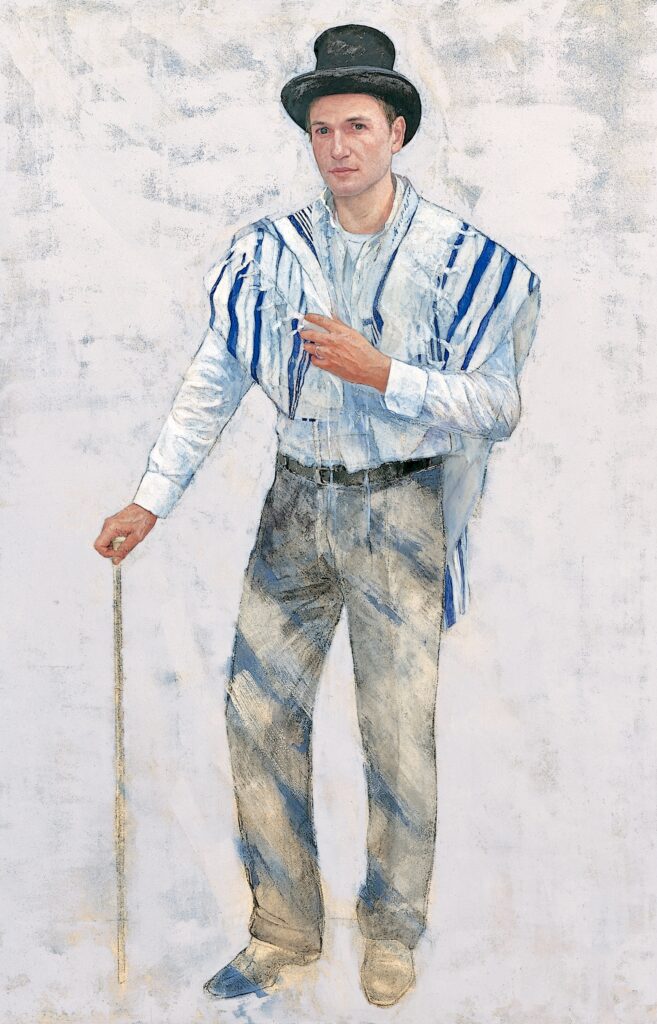
For example, the painting Anglo Sefarad (oil, charcoal and tempera on Japanese paper, 2007) (fig. 1) shows a life-size full-length portrait of an elegant young man from Madrid’s Jewish community who stands in front of us, returning our gaze. The composition reminds us of Goya’s portraits of aristocratic figures like the similarly arranged Duque de San Carlos (1815). Unlike the dark ominous tones that surround Goya’s portraits, a set of luminous hues of blue and white place the subject of Anglo Sefarad in an inviting atmosphere, fully open for the viewer to enjoy. Within it, however, hints of the Sephardi layers of history and experience emerge symbolically from the dandy-like cane, top hat, the white tallit with blue stripes and the sobriety of the black-and-white attire. While some of these elements might be familiar to the average Spanish viewer, they also function as indices of subtle historical and cultural distances. The top hat, for example, may be perceived as a familiar playful symbol connecting the young man to now past conventions of upper-class celebrations and cosmopolitan elegance. Yet, top hats have been used in England (and other countries as well) as a special Shabbat garment by Spanish and Portuguese synagogue officers and congregants.7 Through this polysemic game, the portrait conveys familiarization while simultaneously capturing historical and cultural difference.
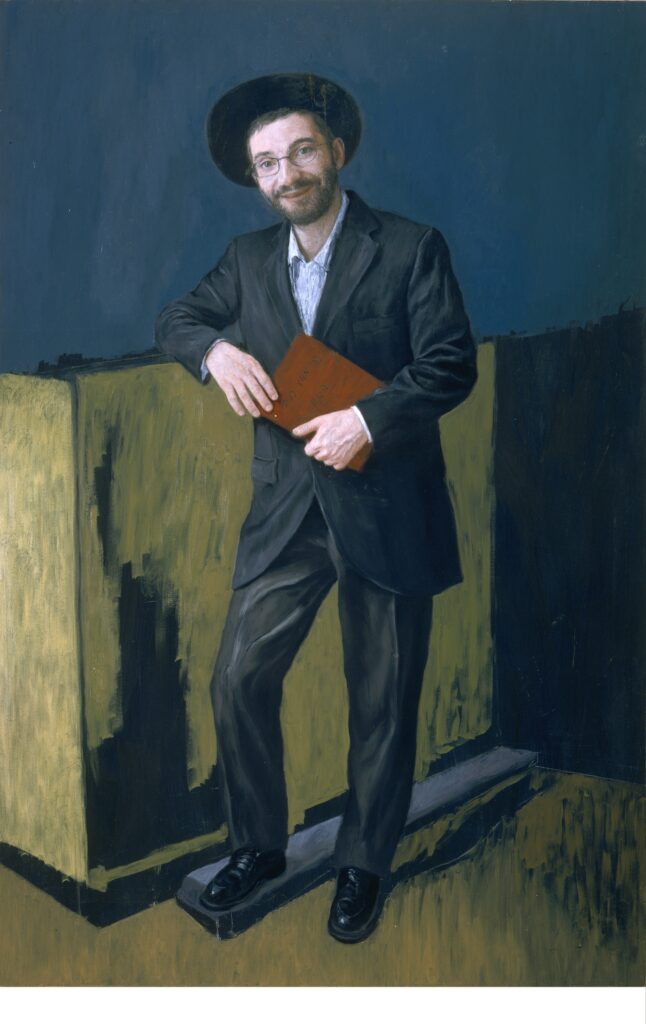
Similarly, Rav Knafo (oil on board, 2009, fig. 2) portrays the rabbi of Bayonne’s community, a community that holds a strong historical connection to the Jews expelled from Spain. Again, the composition resonates with joy and lightness. The smiling Rabi Knafo holds a book in a pose that closely resembles Velázquez’ portraits of humble people as philosophers and wise men. In particular, we can look at the aesthetic filiation with his portrait of Esopo (Aesop, 1640) similarly holding a book, although in much darker, tenebrous tones. Rabbi Knafo’s portrait provides a sense of dignity to the subject and of immediacy and closeness to the viewer. But the subject is not immediately apprehensible: the Hebrew characters on the book, the unshaven face, and the simplicity of the suit and the black hat provide reminders that the Jewish difference is not to be flattened out. The paintings do not represent Sephardi Jews as “Spaniards without a homeland.” They do not erase the multiple attachments of Sephardi Jews or downplay the possibly uncomfortable difference that Sephardi Jews, as Jews, bring with them to Spain.
The book is a leitmotif of several of Quintero’s portraits of contemporary Sephardi men, all of whom appear joyfully reading and studying their books, as we can see in Rabbi Baruj Garzón (2007) or Rabino estudiando Torá (Rabbi Studying Torah, 2013) (fig. 3). In this last portrait, Rabbi Moshe Bendahan, who presides over the Jasdei Leah Sephardi synagogue in Madrid, appears against a blue background that Quintero characterizes as “Moroccan blue,” Morocco being the place from where the Bendahan family migrated to Spain in the 1960s.
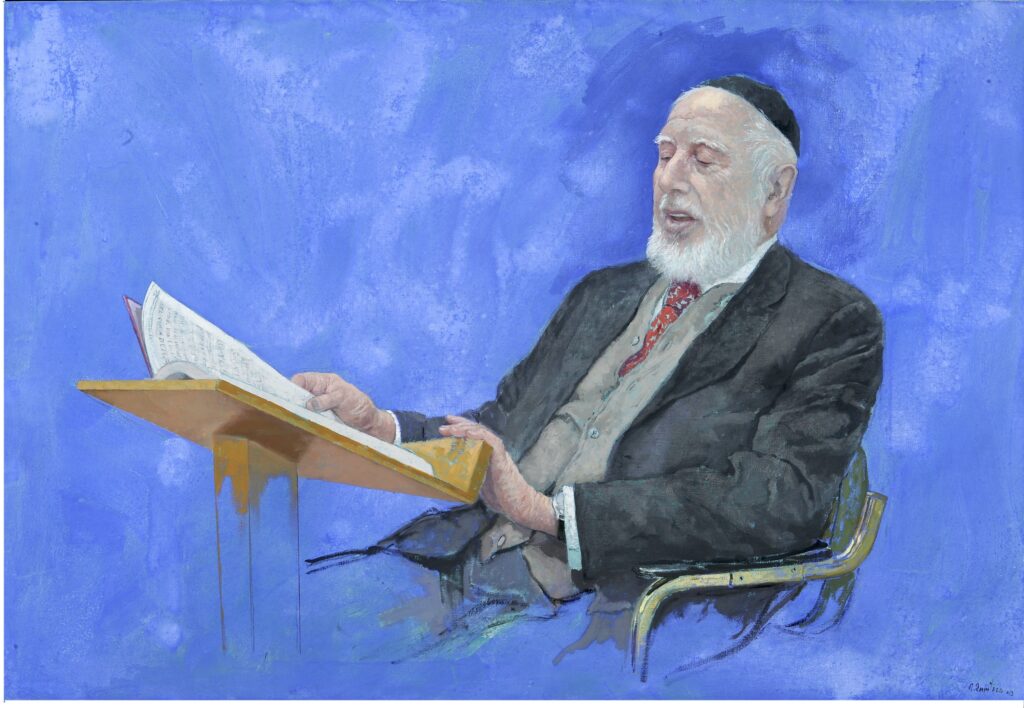
78 x 114 cm, 2013, Private Collection (Courtesy of Daniel Quintero).
If these portraits of present-day Sephardi Jews insert their subjects into a quintessentially Spanish classical visual tradition and thus as subjects of Spanish culture, Quintero’s Sephardi still lifes take this idea of a joyful and respectful welcome one step further. Composed using many of the conventions of the Spanish baroque still lifes, the paintings implicitly reflect on the complex shared ritual and symbolic practices that crisscross Spanish and Sephardi religious celebrations. The similarities are so striking that, at first sight, these might be perceived as Jewish renderings of a Catholic Iberian tradition. Yet, more powerfully, they reveal the Jewish elements present in classic Spanish mysticism, which both inspired and achieved expression through the baroque still life. Thus, in Acerca de Pesaj (About Pesach, 1990) (fig. 4) the traditional food elements of the Passover feast appear represented with the characteristic classic Spanish still life’s frugality and careful attention to the geometric balance of the composition.
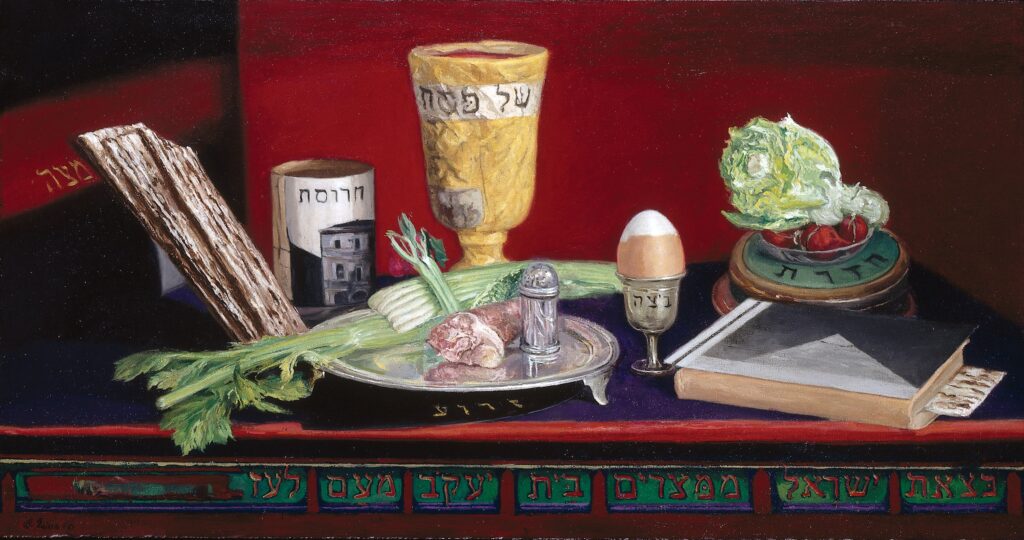
In fact, the painting draws from the style of two mystical painters in this tradition: Juan Sánchez Cotán (1560-1627) and Francisco de Zurbarán (1598-1664). Cotán’s intense attention to the food at its most humble materiality (see Cotán’s Bodegón de caza, hortalizas, y frutas, 1602) combines with Zurbarán’s emphasis on the depiction of tableware (trays, cups, dishes) in such detail that the objects of the painting appear materially palpable (see Zurbarán’s Bodegón con cacharros, 1650). Acerca de Pesaj adds two narrative references placed at opposite corners of the composition. One depicts an Egyptian pyramid on the prayer book’s cover; another image, adorning the cup that holds the haroseth—a symbol of the mortar used by Israelite slaves in Egypt—displays a whitewashed tiled-roof house resembling a traditional Southern Spanish home. The Passover meal serves as the bridge connecting these two symbols of the Exodus and Jewish life in Iberia.
La noche de la Mimona (The Night of Mimouna, 1998) (fig. 5) also emphasizes foods and tableware but its style has moved away from classicism into expressionism and abstract naturalism. The Mimona festival, celebrated by Moroccan Jews on the last night of Pesach, is a Sephardi holiday with origins in the mid-eighteenth century. The mystical dimension reappears here in the translucent quality of the objects portrayed, discernible thanks to the contours, reflections, and decorative fringes indicating their North African origin. The foods symbolizing hope and redemption and the glass tableware appear as ethereal presences floating on a water-like “Moroccan blue” fluid background.
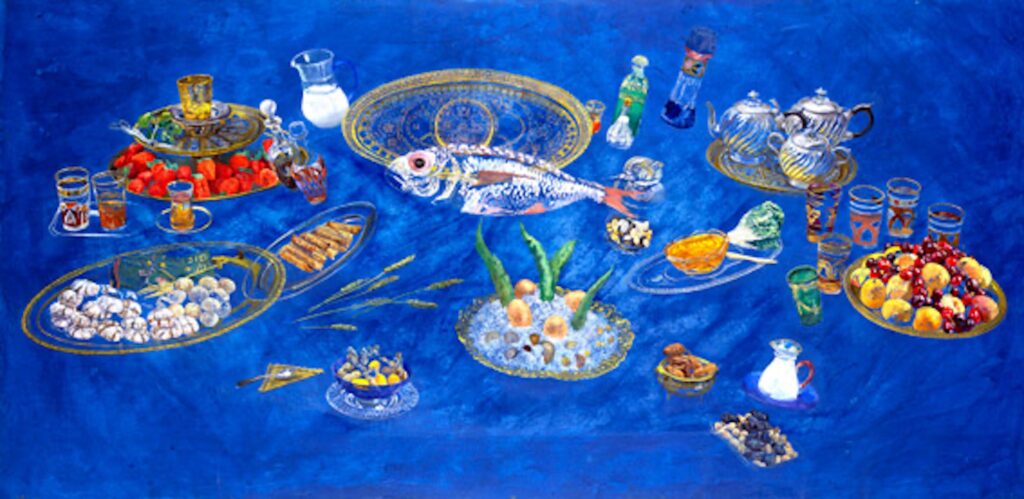
Norman Bryson argues that the classical Spanish painters’ still lifes (like those of Zurbarán and Cotán) create a space in which the mundane transmutes into the supermundane showing the “interpenetration of the ordinary and unassuming with what is exalted and sacred.”8 By situating itself in relation to these classical paintings, Acerca de Pesaj and La noche de la Mimona show the ease with which Sephardi traditions converse with the mystical Catholicism the still lifes represent. In effect, this dialogue makes visible the possibility that the interpenetration of mundane and supernatural in the baroque still lifes was possible because of the existence of another “interpenetration,” another hybridity: that of the shared symbolic universes which emerged among Jews, Christians and conversos in medieval and early modern Spain.
Quintero has explained how, “Siempre, desde el principio, he trabajado el retrato, incluso a través de otros géneros como el bodegón” (From my beginnings, I have always worked in the portrait genre, even by means of other genres such as still life).9 Looking at these still lifes as portraits by other means, Acerca de Pesaj and La noche de la Mimona are portraits of Sephardi Jewish subjects steeped in both Jewish and Catholic traditions and of the mystical threads that run between them. In these still lifes we can see the depiction of North African Jewish cultural objects through the conventions of the Spanish baroque. As a result, in these paintings it is impossible to maintain any kind of binary opposition between Sephardi and Spanish. In doing so, these “portraits by other means” gesture to the Jewish elements that lay invisible as frames of reference for many of Spain’s most traditional ways of constructing its national identity. They show Jewishness as a constitutive part of what has been traditionally understood as Spanish culture.
Quintero’s conscious update of the visual rhetoric of the Spanish classical and baroque traditions in the still lifes and the portraits of contemporary Sephardi Jews finds a complementary gesture in his portraits of contemporary people embodying historical figures of the Iberian Jewish past. Along with his working on Sephardi contemporary figures, Quintero has been carefully searching for models to portray historical figures of medieval and early modern Iberian origin. Quintero’s portraits bring these historical characters back from oblivion and invisibility by reimagining them in the faces of his contemporaries. More specifically, in the case of most of these models, contemporary Spaniards who have undergone experiences of marginalization, injustice or exile.10 He sees in them characteristics that transcend their physical appearance. By looking at their physiognomy as a landscape shaped not so much by genetics, but by their thought and history, Quintero finds in their features a cartography shaped by experiences commensurate with those of the historical figures he wants to depict. He is not exactly painting a person but composing a retrospective construct of these historical figures. This construct is the byproduct of the experiences and works of these individuals, based on traces of their lives that have reached us and to which we have access hundreds of years later.
Some of those lending their faces to the portraits are themselves Jewish; others are not. Symbolically, these Jewish and non-Jewish portraits of the present recall or become traces of the Iberian Sephardi heritage. In them, the debts of past and present violence merge together, one resounding upon the other. The experiences of those posing for these portraits in the present speak to the experience of medieval and early modern historical figures evicted from their homes and removed from traditional Spanish history.11 And the experiences of these historical figures speak to contemporary inhabitants of Spain. The resulting portraits interrogate how to recompose the faces of a community that has been made invisible through a prolonged and deliberate historical process: what traces remain of that which disappeared with those expelled or converted? How to see again that which could not be seen for centuries? Through these visual juxtapositions of past and present, contemporary notions of Spain shift by looking at these notions through the genealogy of Sepharad. These paintings bring this genealogy to the forefront by inserting Jewish subjects at the heart of Spain’s visual tradition.
In one of the earliest paintings in this series, Emiliano Maté como Maimónides (Emiliano Maté as Maimonides, oil on canvas, 1991) (fig. 6), a vagabond, Emiliano Maté, lends his face to Maimonides, the prominent Jewish philosopher, doctor, and Rabbi from twelfth-century Cordoba.
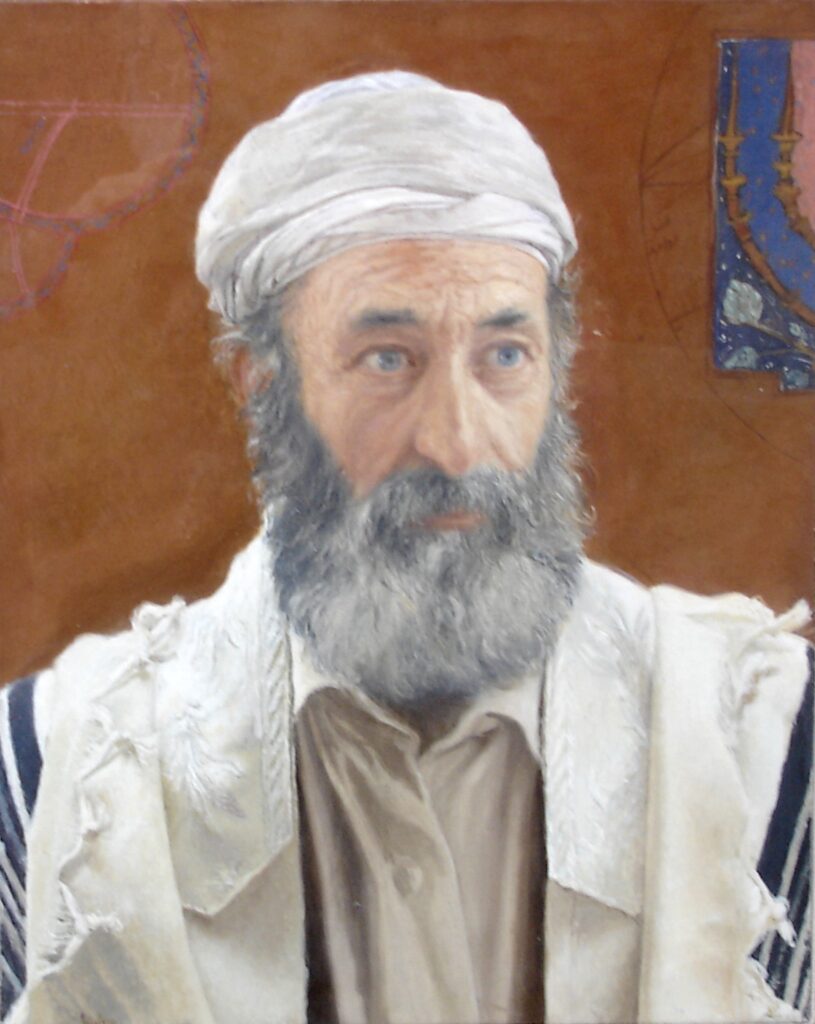
For several years, Quintero had noticed Maté sleeping on a public bench in the Cuatro Caminos neighborhood of Madrid. He learned that Maté had to quit his job as an architectural draftsman to care for his chronically ill and elderly mother. Eventually Maté’s inability to pay his co-op’s expenses as the area gentrified, led his neighbors to take over his apartment and forced him into homelessness. As a form of protest, Maté made the sidewalk across the street from his former apartment his new home. He sat there as a homeless man for thirty years. Quintero felt drawn to him and his story. After speaking with him several times, he convinced Maté to come to his studio and pose for him for several sessions. They spoke about Maimonides, whom Maté already knew about. In the portrait that resulted from these sessions, the traces of resigned suffering in Maté’s persona, the weight of his story as reflected in his body, allow us a glimpse into Maimonides’ experience of religious persecution and recurrent exile. The portrait simultaneously vindicates Matés’ dignity and intelligence and Maimonides’ legacy. The homeless philosopher of the past meets the destitute homeless philosopher of the present.
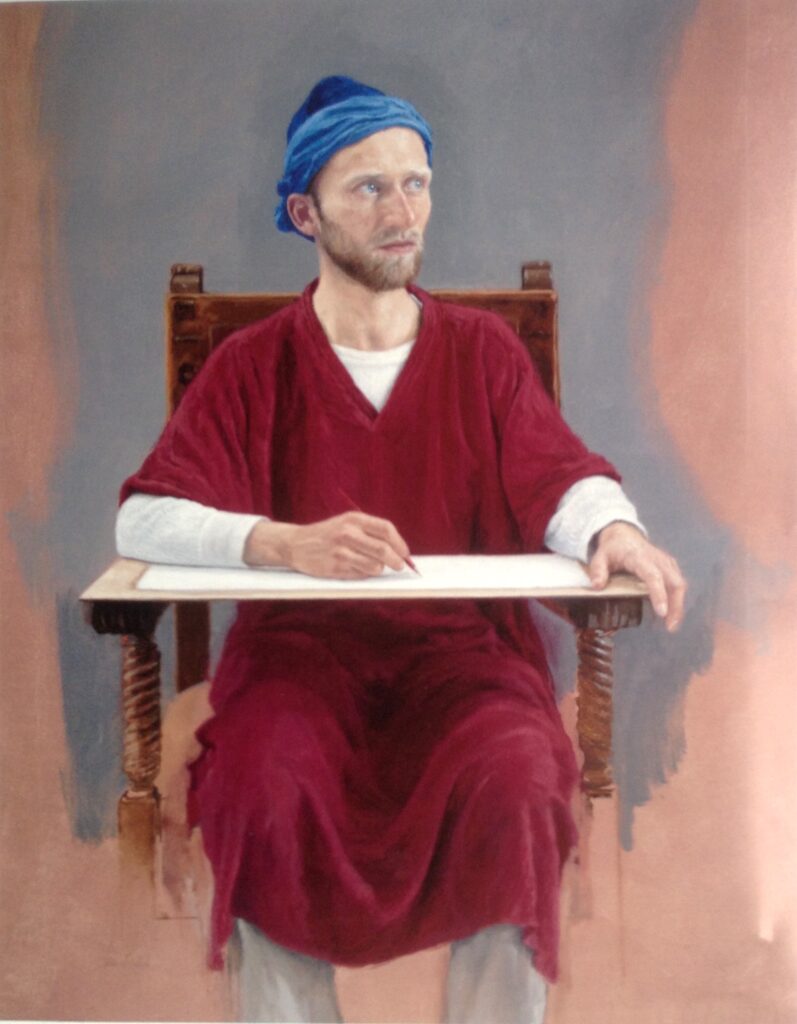
A similar experience occurs with the portrait Benjamin de Tudela (Benjamin of Tudela, oil and tempera on cloth, 1996) (fig. 7). The historical figure was a twelfth- century Jewish traveler and adventurer born in Tudela, Navarra, in 1130. De Tudela began his journey around 1165, visiting Europe, Asia and Africa, and wrote an account, The Travels of Benjamin (also known as Sefer ha-Masa'ot, The Book of Travels), describing the many cities and peoples he encountered, with an emphasis on the Jewish communities he came across.12 Quintero’s model for the portrait was a street performer who busked as a “living statue” in the gardens of the Retiro Park in Madrid. His extreme thinness and his blue, almost translucid gaze seemed to Quintero those of a seasoned traveler. These features helped the painter establish an imaginary relationship between the performer and Benjamin de Tudela. At the time of Quintero’s encounter with the model while walking in the Retiro Park, the painter happened to be reading Tudela’s The Book of Travels.13
As in the case of Maimonides described above, a prominent and influential figure of the Jewish-Iberian past is embodied in a contemporary Spaniard who is defined by precariousness and vulnerability. Benjamin of Tudela’s twelfth-century encounters with different peoples, geographies and customs in his long travels far away from his home in the Iberian Peninsula find a commensurate and paradoxical experience in the body of a street performer in 1990s Madrid. The street performer encounters people from all over the world (the Retiro park is a favorite of international tourists, as well as groups of immigrants who can enjoy this free public space in the center of Madrid) without moving at all, as a living statue.
The portrait Gracia Mendes (oil, charcoal, and tempera on cloth, 2005) (fig. 8) depicts the powerful and famed sixteenth-century Sephardi businesswoman Doña Gracia Nasi. Also known simply as “La Señora,” she was born in Portugal in 1510 into one of the wealthiest Jewish families of the time. The Nasi family had probably emigrated to Portugal from Spain in 1492, opting for exile instead of conversion to Christianity, but, together with other Portuguese Jewish families, they were forced to convert in 1497. Gracia’s Christian name was Beatriz de Luna. Quintero’s portrait uses her married name, Mendes: her husband was Francisco Mendes, a prominent converso merchant who, upon his death, left her in charge of administering his fortune, jointly with his brother and business partner Diogo Mendes. Mendes was Francisco’s Christian last name and Benveniste his Spanish-Jewish one. Francisco’s family had also emigrated to Portugal from Spain, probably in 1492.14 After the establishment of the Inquisition in Portugal in 1536, Beatriz de Luna left Lisbon and established her family subsequently in Antwerp, Venice, Ferrara, and finally in Constantinople, where she adopted the name Gracia Nasi. Throughout her life, Gracia Mendes-Nasi was a patron of Jewish culture and initiatives and a benefactor of New Christians trying to escape Spain and Portugal and resettling in Italian cities and the Ottoman Empire.15
The model that Daniel Quintero found for the portrait of this legendary figure was the Spanish writer Esther Bendahan. Born in Tetuán within a Sephardi family and community, as a child Bendahan moved to Madrid with her family in the early 1970s and has lived there ever since.16 Her experiences of exile, dislocation and adaptation as a Sephardi Jewish woman born in Morocco and raised in Spain, occupy a central place in Bendahan’s work as a fiction writer (see, especially, her 2006 autobiographical novel Déjalo, ya volveremos). She has also been the director of cultural programming at the Centro Sefarad-Israel since its inauguration in the year 2007, and as such she has played a key role in Spain’s official efforts to strengthen diplomatic links with Judaism, Israel, and the Sephardi diaspora.17 Through this institutional role she has also been able to lend support and offer a cultural platform and, thus, a degree of visibility to Sephardi and Ashkenazi Jewish artists and intellectuals living in Spain.
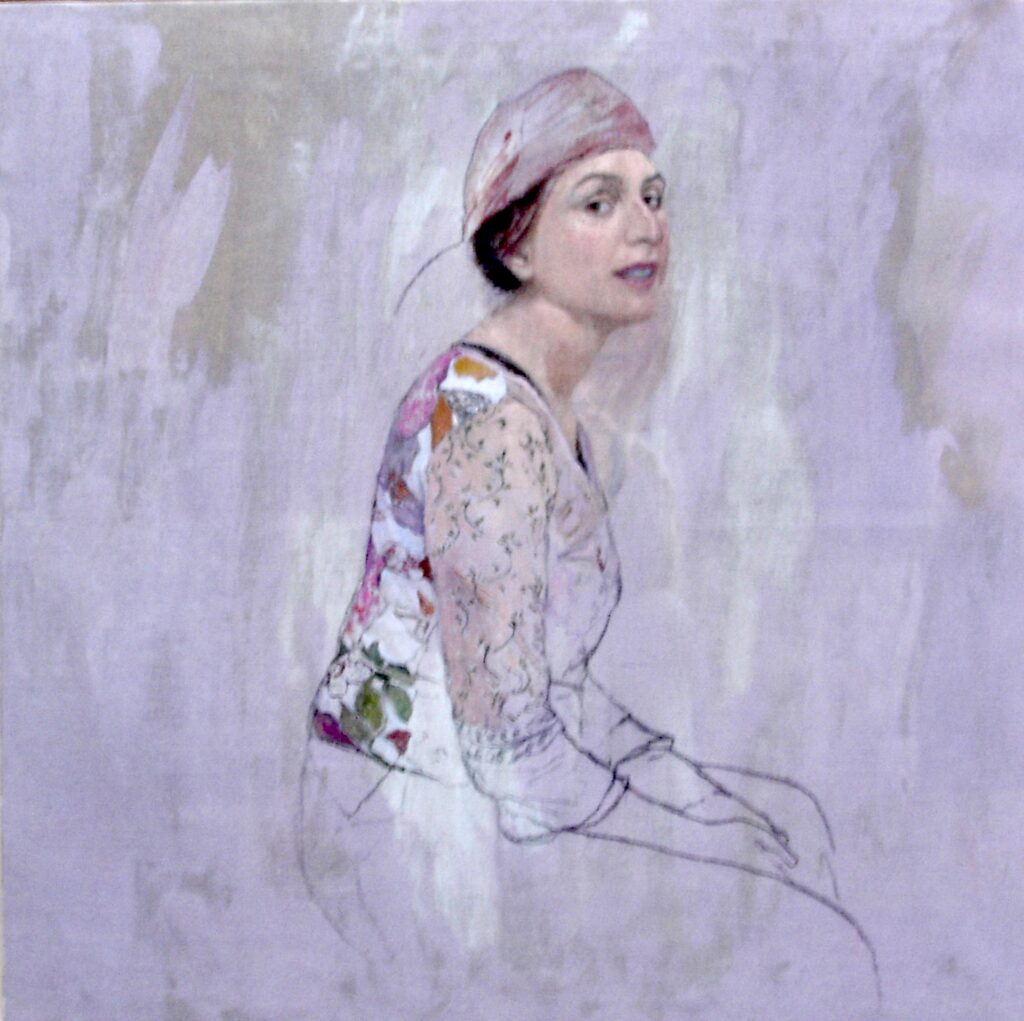
In this portrait of Gracia Mendes through Esther Bendahan, we see once again a commensurability of experiences between the historical figure portrayed and the present-day model used to portray it. Both are strong, influential women in their communities, marked by experiences of mobility and diaspora, committed to supporting Sephardi causes and culture.
In this portrait we can also see clearly the deep collaboration that Quintero establishes with his models in the process of constructing these historical portraits. Quintero has explained how
Me cuesta más trabajo a veces encontrar un modelo que pintar el cuadro, porque, al final, un retrato se hace entre dos, no solamente el pintor. Son el pintor y el modelo los que trabajan conjuntamente (Often it is more difficult for me to find a model than to paint the portrait, because, at the end, a portrait is constructed by two people, not just the artist. The artist and the model work together).18
Bendahan was interested in the idea of posing for a portrait of “la Señora” when Quintero proposed it to her, because she was well aware of Gracia Nasi’s historical significance and had written an article about her. Bendahan moreover chose to wear garments that she herself owned at the many modeling sessions the creation of the portrait entailed.19
Perhaps it is the portrait Retrato de Samuel Ha-Leví (oil on canvas, 2000) (fig. 9) which best exemplifies the hopes implicit in this group of paintings and, more generally, of Spain’s efforts, in the last thirty years or so, to revisit and re-evaluate the Spanish Jewish past. The painting, owned by the Sephardi Museum in Toledo, portrays Halevi, the treasurer and diplomat from the fourteenth century who built the Synagogue of el Tránsito in Toledo. Halevi had risen to a position of great prominence and wealth by successfully managing King Pedro’s finances and overseeing his tax collection. He also served as the King’s confidential advisor, taking part in many important political and economic decisions. Even so, in 1360 or 1361, shortly after the synagogue’s completion, he and his kinsmen throughout Castile were arrested in Toledo for reasons that were never clearly stated and still remain uncertain to this day. As Yitzhak Baer describes it, “[h]e was taken from Toledo to Seville; and, after an attempt had been made to extort a large sum of money from him, he died in prison under torture, like other Jews before him.”20
Halevi served Pedro at an especially difficult time for Iberian Jews. The spread of the Black Death beginning in 1348, for which Jews were blamed, produced general religious and social unrest and violent attacks on Jewish communities throughout Castile and Aragon. The civil war that ensued in 1366-69 between Pedro and his half-brother Enrique of Trastámara had devastating consequences and intensified the already increasing wave of anti-Jewish sentiment. Enrique, seeing an opportunity to use Pedro’s political and economic reliance on Jews such as Halevi as a propaganda tool, began calling his brother “King of the Jews.” The accusation that Pedro showed special favor to Jews was completely false, but it has had a “persistent lure, power and effectiveness.”21 As a result, Jews were further persecuted and, in the case of several communities in northern Castile, massacred upon Enrique’s victory. Years after this civil war, representations of Halevi as the archetype of the hated Jew who takes advantage of Christians were still widely disseminated in Toledo and Castile. In 1378, shortly after the end of the Trastámara civil war, Ferrand Martínez, Archdeacon of Écija, began his vehement sermons in Seville inciting violence against Jews. His preaching resulted in the unprecedented massacres and mass conversions that destroyed most Jewish communities and their material culture in Spain throughout 1391.22
The model for the portrait of this consequential historical figure for Spanish Jewish history was Máximo Cajal López (1935-2014), the Spanish diplomat who acquired notoriety in 1980 as ambassador in Guatemala when a group of indigenous Guatemalan peasants occupied the Spanish embassy to protest their harrowing working conditions. With the embassy surrounded by the police and armed forces, Cajal offered himself as negotiator to find a peaceful solution to the occupation. The Guatemalan government, however, decided to raze the embassy, which eventually burned. Thirty-seven people died, including Spanish diplomats, Guatemalan opposition politicians and indigenous leaders. Cajal escaped through a window and survived with third-degree burns over most of his body. At that time, Spain was consolidating a mostly peaceful transition to democracy after the death of dictator Francisco Franco in 1975. Cajal’s calls for dialogue during the occupation of the embassy in Guatemala were emblematic of the recent lessons of Spain’s transition to democracy, seen at this time as an example for how to reach consensus through dialogue among highly divergent political views.
After returning to Spain, Guatemalan and Spanish right-wing groups tried to discredit Cajal. Guatemalan sources close to the positions of General Lucas García, Guatemala’s president at the time, accused Cajal of being a communist who had collaborated with the peasants to organize the assault. Nevertheless, Cajal continued a successful diplomatic career. However, upon the publication of his 2003 book arguing for the need to return the Spanish cities of Ceuta and Melilla to Morocco, many Spanish political figures questioned his loyalty to Spain. The public uproar escalated to the point that his party, the Spanish Socialist Party (PSOE), revoked his membership. Although not literally, like Halevi, Cajal was also sacrificed by the government he had served.23
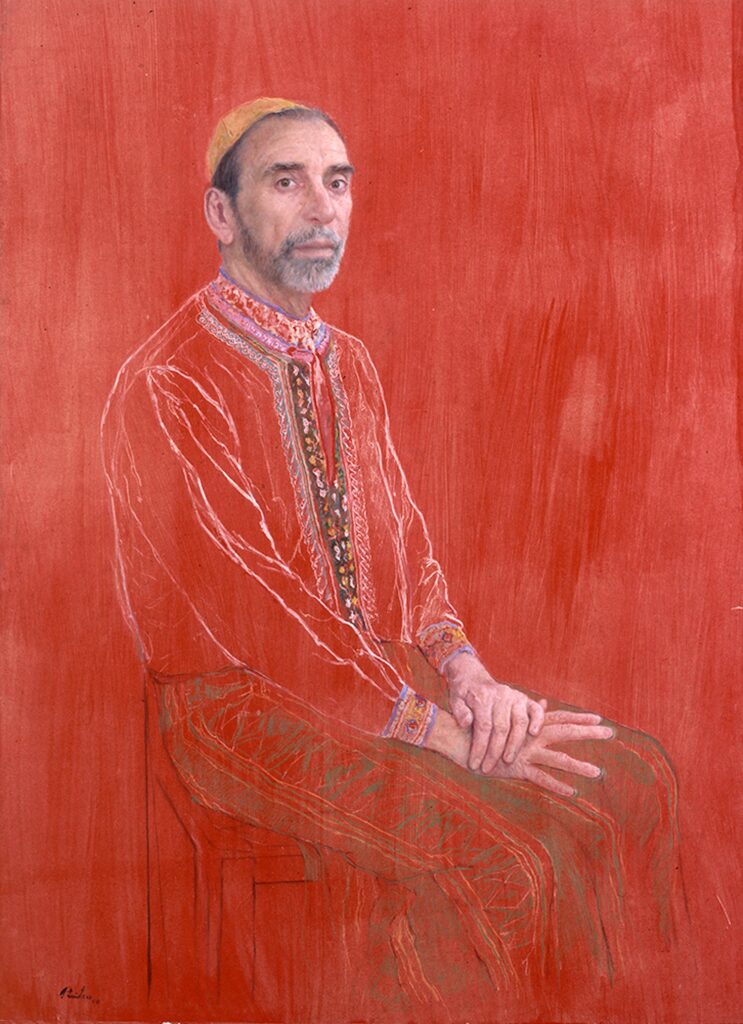
While painting the ambassador’s official portrait, Quintero was inspired by Cajal’s face and the gravity of his expression, in which he perceived traces of the suffering left by these events. Cajal fully embraced the idea of embodying Samuel Halevi and participated very effectively in the creative process, resulting in “a perfect symbiosis” (Quintero’s characterization) between the two figures.24 In linking Halevi to this contemporary Spaniard, the diplomat who embodied the values of a newly democratic Spain in the 1980s, the painting invites us to reimagine the death of the medieval Jewish Royal treasurer in relation to the courageous life of Cajal. The painting blends the plight of the two men.: Halevi, the Jew condemned to death by the King he served, whom Christians were taught to hate,25 becomes re-imagined in Cajal: the contemporary diplomat who tried to avert tragedy through dialogue, endured criticism by many of the people for whom he worked, and banishment from his political party. Present and past come to illuminate and influence each other.
The portrait further invites viewers to contemplate themselves critically as part of a democratic society that defends tolerance and dialogue. Red, a color associated with the bloodshed of violence, becomes here the ethereal substance from which Halevi’s head and hands emerge. In its trans-historic condensation of dual historical periods and people, the painting helps us entertain an alternative vision of Spanish identity. Cajal provides visible presence to Halevi, and through it, to the silenced history of Jewish Spain. Halevi, in turn, suggested not only in the countenance of the portrait but also in the clothing and the color red, allows us to historicize Cajal’s role in Spanish political life.
If these portraits performatively represent the experiences of contemporary people in Spain as “traces” of historical figures of Iberian Judaism, the portraits of today’s Sephardi Jews perform a reciprocal genealogical connection by representing figures of the Sephardi diasporic present through Quintero’s conscious update of the quintessentially Spanish visual tradition. These portraits and the still lifes as “portraits by other means” present Sephardi identity as both internal and external to Spain, as part of Spain but not subsumed by it.
It is worth remembering that the emergence of the Inquisition in Spain was intimately related to an anxiety of indifferentiation. After the unprecedented mass conversions that took place in 1391, it became impossible to distinguish who was a Christian and who was a Jew. The Inquisition’s main charge was to re-establish the boundaries that conversion and coexistence had blurred.26 As Jonathan Ray has explained, the phenomenon of the conversos, as well as the blurring of the lines between Christianity and Judaism it produced, “represents one of the most important and enduring legacies of the Jewish presence in medieval Iberia.”27 When Quintero uses non-Jewish Spaniards for his portraits of medieval Iberian Jews (Emiliano Maté for Maimonides, the Retiro Park performer for Benjamin de Tudela, Máximo Cajal for Halevi), it is possible to interpret this choice of models as suggesting a possible genetic continuity, along the lines of the claims of those who self-identify as descendants of Iberian Jews. Could there be “traces” of those medieval Jews in present-day Spaniards? Could present-day Spaniards be descendants of those Jews who converted to Christianity and stayed in Spain, eventually blending in and “forgetting” their Jewish identity? Yes. But this tantalizing yet mainly unverifiable28 possibility is not the focus of the portraits. As we have shown, the relationship of models and historical figures is more complex than that, encompassing relations between past and present that suggest not necessarily genetic continuity, but rather ways of being in the world through experiences that can speak to one another.
In modern and contemporary Spain, antisemitism has developed in spite of the near absence of Jews, the widespread ignorance about their pre-1492 presence and the strategies of gradual erasure and silencing imposed on conversos and their descendants. In this context, the newly gained, yet tentative, visibility of Spain’s Jewish past has ignited a wide array of identifications, misidentifications and what Emmanuel Levinas calls acts of “obligation.” At times obligation presents itself as an epiphany which reveals the presence of “humanity as a whole, in the eyes that look at me.”29 These eyes, and the face, are for Levinas “the living presence” of another person as an undeniable expression, a discourse that “speaks to me and invites me to a relation.”30 Those eyes are thus the face, the presence and they are also the trace.
Levinas defines a trace as “a presence of that which properly speaking has never been there, of what is always past.”31 He pushes the trace beyond its primary indexical relation to an absent referent that remits to an indefinite past, the footprints on the sand that point to the person that once walked on that beach. For him the very presence of the trace becomes evidence of the existence of an absolute other stemming from an unrecoverable past. In this sense, the trace, he argues, is like a sign in that it points to a meaning, but, unlike a sign, it refuses disclosure.32 The trace is a presence that refuses to fully reestablish its relation to that in which it originated. In Levinas’ argument, the human face becomes the ultimate incarnation of his concept of “the trace” as he points to the inherent abstractness of our faces and their ultimate resistance to disclose that of which they are a trace.
Our own curatorial dreaming of Quintero’s paintings seeks to make explicit their creative memory work; that is, the ways these paintings explore traces of the past in the present and of the present in the past. Through their status as signs that simultaneously point to and refuse to fully disclose a meaning, these traces have the generative ability to open up a space in which to reimagine not only the Iberian Jewish past, but also the post-1492 Iberian Jewish futures that never were, and a present constituted by all of these temporalities.
Through its aesthetic engagement with classical traditions of seeing and painting, Quintero’s work constructs a narrative about a shared past that, as described by Hall, offers the possibility of new conceptions of cultural identity. His “Sephardi Portraits” invite viewers to expand their understanding of Spain in order to acknowledge its Jewish genealogies—the full extent of the implications of its Jewish past in its present—and the full belonging of Spain’s Jewish communities to the Spanish nation past and present.
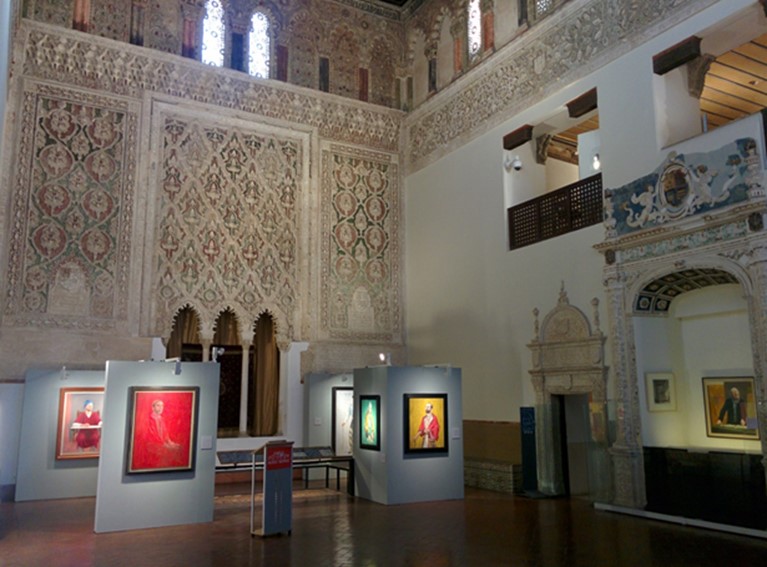
[1] Stuart Hall, “Cultural Identity and Diaspora,” Identity: Community, Culture, Difference, ed. Jonathan Rutherford (London: Lawrence & Wishart, 1990), 225.
[2] Shelley Ruth Butler and Erica Lehrer, “Introduction: Curatorial Dreaming,” Curatorial Dreams. Critics Imagine Exhibitions, eds. Shelley Ruth Butler and Erica Lehrer (Montreal and Kingston: McGill-Queen’s University Press, 2016), 4.
[3] Ibid, 6. Several of the paintings analyzed in this article were part of an exhibition of Daniel Quintero’s Sephardi-themed work at the state-owned Museo sefardí in Toledo, entitled “Memoria escondida/Hidden Memory.” We collaborated in this exhibition, writing the text that introduced visitors to the paintings.
[4] Fietta Jarque, “Daniel Quintero recrea sus emociones ante la cultura sefardí,” El País, September 6, 2000. Accessed December 10, 2020, http://elpais.com/diario/2000/09/06/cultura/968191209_850215.html.
[5] See Benmayor and Kandiyoti’s essay “Ancestry, Genealogy and Restorative Citizenship” in this volume for a discussion of self-identified converso descendants’ interest in the Spanish and Portuguese laws of nationality. See also Kandiyoti, The Converso’s Return. The Afterlives of Conversion in Contemporary Literature and Culture (Stanford: Stanford University Press, 2020), which analyzes the cultural contexts and literary production that have emerged from the reawakening of interest in converso history, ancestry and identity in the Americas, Europe, and Turkey in the last few decades. See also Charles A. McDonald, “Return to Sepharad: Citizenship, Conversion, and the Politics of Jewish Inclusion in Spain,” (PhD diss., New School for Social Research, 2019) and Daniela Flesler and Adrián Pérez-Melgosa, The Memory Work of Jewish Spain (Bloomington, IN: Indiana University Press, 2020).
[6] The senator Ángel Pulido y Fernández (1852-1932) became the leader of philosephardism, a movement that sought to expand Spain’s influence in the Mediterranean and advance Spain’s colonial ambitions over Morocco through the cultivation of links with Sephardi Jews. Pulido consistently downplayed Sephardi Jews’ Jewish identity. Much of the rationale and language of the 2015 Law of Nationality for Sephardi Jews, which provides a path to citizenship to those who can prove descent from Jews expelled from Spain in 1492, is connected to these early twentieth-century philosephardi views of Sephardi Jews that emphasize their “Spanish” identity. For more on the philosephardi echoes in this Law, see Tabea Linhard, Jewish Spain. A Mediterranean Memory (Stanford: Stanford University Press, 2014).
[7] For a history of the use of top hats in Sephardi communities in England see Abraham Gilam, The Emancipation of Jews in England 1830-1860 (London: Garland Publishing, 1982), 4-6.
[8] Norman Bryson, Looking at the Overlooked: Four Essays on Still Life Painting (London: Reaktion Books, 1990), 79.
[9] “Siempre, desde el principio, he trabajado el retrato, incluso a través de otros géneros como el bodegón,” Pablo Bujalance, “Daniel Quintero abre en el Episcopal la mirada más amplia a su pintura,” Malaga Hoy, January 24, 2008. Accessed December 10, 2020, http://www.malagahoy.es/ocio/Daniel-Quintero-Episcopal-amplia-pintura_0_116388808.html
[11] In an article in El País—Spain’s leading newspaper—about Quintero’s portrait of Maimonides using a homeless man as a model, writer Manuel Vicent talks about “personajes sefardíes de la Edad Media que fueron desahuciados de la historia española” (Sephardi figures that were evicted from Spanish history), Manuel Vicent, “Un mendigo llamado Maimónides,” El País, November 10, 2017. Accessed December 10, 2020. https://elpais.com/cultura/2017/11/10/actualidad/1510348645_173248.html?id_externo_rsoc=whatsapp.
[12] Martin Jacobs, “ ‘A Day’s Journey’: Spatial Perceptions and Geographic Imagination in Benjamin of Tudela’s Book of Travels,” Jewish Quarterly Review 109, no. 2 (2019): 203-32.
[13] Interview in Daniel Quintero’s studio, Madrid, July 2016.
[14] See Herman Prins Salomon and Aron di Leone Leoni, “Mendes, Benveniste, De Luna, Micas, Nasci: The State of the Art (1532-1558),” Jewish Quarterly Review 88 (1998): 135-211 for a reproduction and discussion of the letters penned by the King and Queen of Portugal vouching for the reputation of the Mendes brothers and for the different names by which these distinguished families were known.
[15] See Cecil Roth, Doña Gracia of the House of Nasi (Philadelphia: The Jewish Publication Society of America, 1948); Libby Garshowitz, “Gracia Mendes: Power, Influence and Intrigue,” in Power of the Weak: Studies on Medieval Women, eds. Jennifer Carpenter and Sally Beth MacLean (Urbana Champaign: University of Illinois Press, 1995): 94-125, Andrée Aelion Brooks, The Woman who Defied Kings: The Life and Times of Doña Gracia Nasi (St. Paul: Paragon House, 2002).
[16] Bendahan is one of the very few Hispano- Sephardi writers in Spain today. For a thorough account of the history and social organization of Hispano-Moroccan Jews, see Jacobo Israel Garzón, Los judíos hispano-marroquíes (1492-1973) (Madrid: Hebraica Ediciones, 2008). The Jewish communities in northern Morocco were re-hispanized at the time of the establishment of the Spanish Protectorate (1912-1956). Bendahan grew up speaking Haketía (a mix of Spanish, Hebrew and Arabic) at home, but her first schooling in Tetuan (the capital of the Protectorate) was in one of the schools of the Alliance Israélite Universelle (AIU), a tool of French cultural expansion among Jews living in Muslim countries. Spain was never able to compete with these schools in terms of cultural and linguistic influence. See Isabelle Rohr, The Spanish Right and the Jews, 1898-1945: Antisemitism and Opportunism (Brighton: Sussex Academic Press, 2007), 17. Following Morocco’s independence in 1956, and again in the context of the Six Day War in 1967, most Moroccan Jews left Morocco for Israel, Latin America, Canada, France or Spain. In Spain, they organized the basis of today’s Jewish communities.
[17] The Center was created in 2007 as part of Spain’s diplomatic efforts towards Israel and the Jewish world. It was added to pre-existing Centers or “Casas” dedicated to cultural relations and public diplomacy with different parts of the world: Casa América, Casa Asia, Casa Árabe, Casa África.
[18] “El entorno de Daniel Quintero,” interview on the TV program Shalom, accessed December 10, 2020, http://www.rtve.es/alacarta/videos/shalom/shalom-entorno-daniel-quintero/5125018/
[19] Email communication, December 29, 2019.
[20] Yitzhak Baer, A History of the Jews in Christian Spain, vol. 1, (Philadelphia: The Jewish Publication Society, 1992,), 364.
[21] Clara Estow, Pedro the Cruel of Castile, 1350-1369 (Leiden and New York: Brill, 1995), 173. “The love of Jews” was a common, powerful form of criticism labeled against Christian Kings and frequently arose around debates over the limits of royal power. The accusations against King Pedro are a perfect example of this phenomenon, Nirenberg, Anti-Judaism: The Western Tradition (New York-London: W. W. Norton & Co, 2013), 197-200.
[22] Yitzhak Baer, A History of the Jews in Christian Spain, vol. 1, 362-369.
[23] Máximo Cajal, ¡Ceuta y Melilla, Olivenza y Gibraltar. ¿Dónde acaba España? (Madrid: Siglo XXI, 2003); Id., Sueños y pesadillas: memorias de un diplomático (Barcelona: Tusquets, 2010).
[24] Email communication, August 21, 2015.
[25] The antisemitic legends surrounding the figure of Halevi still hold power today. See Flesler and Pérez-Melgosa, The Memory Work of Jewish Spain (Bloomington, IN: Indiana University Press, 2020) for a discussion of different commemorations of Halevi’s figure in Toledo’s public plaques and monuments.
[26] David Nirenberg, “Mass Conversion and Genealogical Mentalities: Jews and Christians in Fifteenth-Century Spain,” Past and Present 174 (2002): 10-12.
[27] Jonathan Ray, After Expulsion: 1492 and the Making of Sephardic Jewry (New York: New York University Press, 2013), 160. The precise status of the conversos, their degree of “Jewishness,” the sincerity of their conversion, and the motivations behind their actions have been the subject of numerous and heated debates. See Yosef Hayim Yerushalmi, From Spanish Court to Italian Ghetto. Isaac Cardoso: A Study in Seventeenth-Century Marranism and Jewish Apologetics (New York: Columbia University Press, 1971); David M. Gitlitz, Secrecy and Deceit: The Religion of Crypto-Jews (Albuquerque: University of New Mexico Press, 2002); David Nirenberg, Neighboring Faiths: Christianity, Islam, and Judaism in the Middle Ages and Today (Chicago: Chicago University Press, 2014).
[28] Jonathan Freedman, “Conversos, Marranos, and Crypto-Latinos: The Jewish Question in the American Southwest (and What It Can Tell US About Race and Ethnicity),” in Boundaries of Jewish Identity, eds. Susan A. Glenn and Naomi B Sokoloff (Seattle: University of Washington Press, 2010), 194. See also Kandiyoti, The Converso’s Return and McDonald, “Return to Sepharad.”
[29] Emmanuel Levinas, Totality and Infinity: An Essay on Exteriority (Dordrecht, Boston, London: Kluwer Academic Publishing, 1991), 213.
[30] Levinas, Totality and Infinity, 66 and 198.
[31] Emmanuel Levinas, “The Trace of the Other,” in Deconstruction in Context, ed. Mark C. Taylor (Chicago and London: The University of Chicago Press, 1986), 345-59 and 358.
[32] In his words, “Disclosure which reinstates the world and leads back to the world, and is proper to a sign or a signification, is suppressed in traces,” Levinas, “The Trace of the Other,” 357.
Daniela Flesler is the author of The Return of the Moor: Spanish Responses to Contemporary Moroccan Immigration (West Lafayette, IN: Purdue University Press, 2008).
Adrián Pérez Melgosa is the author of Cinema and Inter-American Relations: Tracking Transnational Affect (New York-London: Routledge, 2012).
Both are Associate Professors of Spanish at Stony Brook University in NY, USA co-editors, with Tabea A. Linhard, of Revisiting Jewish Spain in the Modern Era (London: Routledge, 2013), and The Memory Work of Jewish Spain (Bloomington, IN: Indiana University Press, 2020).